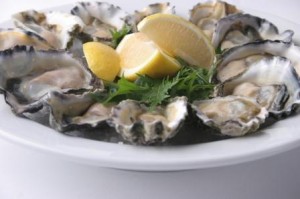 Like many of my patients, I share a love of oysters. They taste great and are chock full of health benefits such as being low in cholesterol, high in protein and B vitamins, a good source of vitamin A and C and also contain many important minerals like zinc, magnesium, iron, copper, iodine and phosphorus.
Like many of my patients, I share a love of oysters. They taste great and are chock full of health benefits such as being low in cholesterol, high in protein and B vitamins, a good source of vitamin A and C and also contain many important minerals like zinc, magnesium, iron, copper, iodine and phosphorus.
That said it could be a little tricky deriving the health benefits from oysters when you also have to contend with a real drawback – they can be poisonous. That’s right; however, only when they are eaten raw or improperly steamed. Let’s talk about how to avoid getting food poisoning from oysters and reap only their health benefits.
What’s So Bad About The Good Oyster?
Oysters have been enjoyed as a sea food for eons and have, as noted above, significant health benefits, especially for men. They contain a lot of zinc which can help with building or maintaining good testosterone production (likely why they’re touted as being an aphrodisiac!) and are a good source of niacin, B3, which helps control cholesterol.
However, oysters also carry with them dangerous bacteria called vibrio vulnificus, a warm salt sea water-borne bacterium that can make you very, very ill or worse. In fact, vibrio poisoning is a significant problem in Japan where much raw seafood (sushi) is consumed daily. Symptoms of eating vibrio infected food typically show up within 16 hours to 2 days and can include:
- Abdominal pain
- Vomiting
- Diarrhea
- Loss of appetite
- Fever
- Fatigue
- Fatal blood-borne infection in people with impaired immune systems or liver disease.
Symptoms of allergy to oysters may initially be mistaken as food poisoning when eating oysters (or other shellfish). Food allergy symptoms come on much faster and can be much more severe in their presentation. Though both food allergy and food poisoning warrant medical care, food allergy symptoms, especially those to shellfish, can be life threatening within minutes if medical care is not sought.
While the above noted symptoms occur frequently with food poisoning, the following are more likely related to food allergy and medical care should be sought immediately:
- Facial, lips or tongue swelling
- Hives
- Difficulty breathing
- Nasal congestion
Who’s At Risk?
Anyone who consumes raw seafood on a regular basis, such as sushi restaurants, or other venues, ups their risk for the vibrio bacteria, as it can also be present in other warm salt-sea water food as well. Others at risk for food poisoning by vibrio bacteria include:
- Pregnant women (should not eat shellfish at all)
- Children (developing immune system)
- Elderly (decreased immune system)
- People with diabetes
- People who take antihistamines, steroids, antibiotics
- People with chronic liver or kidney disease
How To Avoid Food Poisoning From Oysters
It’s important to remember that oysters have been enjoyed for centuries and continue to be a delicious and safe choice on the menu of many seafood restaurants that routinely take necessary storage and cooking precautions. If you are preparing oysters on your own, this is how to safely store and prepare them:
- Refrigerate. The vibrio bacteria are destroyed by adequate refrigeration below 40 degrees.
- Boiling. Vibrio is destroyed at 140 degrees Fahrenheit.
- Check for signs of spoilage. Raw oysters should have plump white and gray flesh and smell like sea air. If they smell fishy or look shriveled or discolored, discard them.
- Follow hygienic preparation. Clean preparation area is important. Immediately disinfect cutting boards, countertops, utensils that oysters have touched. Be sure to wash your hands and forearms adequately with antibacterial soap after preparing oysters.
- Boil correctly. Do not overcrowd oysters in a pot, which may prevent adequate cooking in some oysters. Stick to 1 lb of oysters at a time. Make sure water covers them completely and boil for minimum 3 minutes.
- Inspect. The cooked/boiled oysters should appear plump with curled edges. If they appear shriveled, fall apart, or look discolored, throw them out, they could be infected.
I enjoy cooked oysters whenever possible and I wholeheartedly recommend them. Eating oysters, and other shellfish, in a reputable restaurant should pose no concern of getting a vibrio infection. If you prepare oysters on your own at home, just be sure to follow proper storage, handling and cooking precautions and you’ll reap the many health benefits of oysters and none of their health concern.
Stay Well,
Mark Rosenberg, M.D.
Bacterial Food Poisoning, http://aggie-horticulture.tamu.edu/extension/poison.html
Food Poisoning, vibrio vulnificus, http://www.medterms.com/script/main/art.asp?articlekey=16212&page=2
Raw Oysters and Food Poisoning, http://www.livestrong.com/article/387513-raw-oysters-food-poisoning/
Photo Credit: chincoteague-island.net
